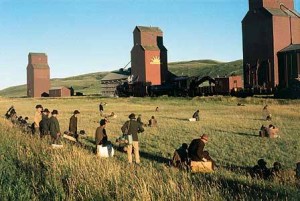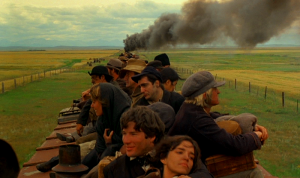
Wheat fields, harvesters, sunrises, big blue skies and a Gothic mansion. At the dawn of 20th century rural-pastoral America in Terrence Malick’s masterpiece Days of Heaven (1978), Richard Gere and Brooke Adams are farmhands whom claim to be brother and sister but in truth are clandestine lovers. Gere’s kid sister (Linda Manz) tags along, offering dispassionate narration throughout. Gere lets Adams marry plantation boss Sam Shepard to escape a life of grueling work. The three of them are family, living under the same roof. Delayed gratification seems easy when Shepard is diagnosed with an incurable cancer which means that Gere and Adams will soon inherit the property. Then Shepard is told he will live, and he plans on a long and fruitful marriage ahead of him. Gere and Adams continue to frolic in hidden locations, but living a lie takes its toll. A grievous love triangle transpires.
Opting to shoot in Calgary and throughout Alberta, Canada as well as a few scenes of his native Texas, Malick gave us indelible locations to dream about. Foremost a visual feast, Malick’s “Days of Heaven” is among the five most beautifully photographed films  ever made but his fastidious technique is utmost crucial. Believing in the principles of natural lighting, Malick’s strategy was to film as much as possible at sunrises and sunsets in what he called the “Magic Hour.”
ever made but his fastidious technique is utmost crucial. Believing in the principles of natural lighting, Malick’s strategy was to film as much as possible at sunrises and sunsets in what he called the “Magic Hour.”
Cinematographer Nestor Almendros called this “a euphemism, because it’s not an hour but around 25 minutes at the most. It is the moment when the sun sets, and after the sun sets and before it is night. The sky has light, but there is no actual sun. The light is very soft, and there is something magic about it. It limited us to around twenty minutes a day, but it did pay on the screen. It gave some kind of magic look, a beauty and romanticism.” Almendros won an Oscar for his work, but was grateful to colleague Haskell Wexler who was credited with “additional photography.”
You are not likely to find any quotes by Malick attached to any of his films. When “The Tree of Life” (2011) won the Palm d’Or at the year’s Cannes Film Festival he did not make a speech, although he appeared happy to be on the French Riviera. He explained in one  furtive statement, “The work should speak for itself.” As high-brow as each of his films have proven, he is equally modest on every one of them. The one tidbit he admits in regards to “Days of Heaven” was that he was “crushed” when first choice John Travolta turned down the part (Travolta twenty years later had a cameo role in Malick’s “The Thin Red Line”). It worked out for Gere idolizers – “Days” is the best performance of his younger years.
furtive statement, “The work should speak for itself.” As high-brow as each of his films have proven, he is equally modest on every one of them. The one tidbit he admits in regards to “Days of Heaven” was that he was “crushed” when first choice John Travolta turned down the part (Travolta twenty years later had a cameo role in Malick’s “The Thin Red Line”). It worked out for Gere idolizers – “Days” is the best performance of his younger years.
Near the end of his classic film, Malick mesmerizes us with a locust swarm, a fire, a manhunt down a river, and a wistful final scene that virtually expresses, “It was nice while it lasted.” The music theme, referencing Aquarium from “The Carnival of the Animals” ballet by Charles-Camille Saint-Saens, inspires a reverie of an antique music box from the old century. When I hear this music to this day, in any other presentation, it summons up memory of “Days of Heaven.”
94 Minutes. Rated PG.
PERIOD DRAMA / SCENIC IMAGERY / WEEKEND TRANCE-OUT
Film Cousins: “Map of the Human Heart” (1993); “Wings of the Dove” (1997); “Silent Light” (2009, Mexico); “To the Wonder” (2013).





